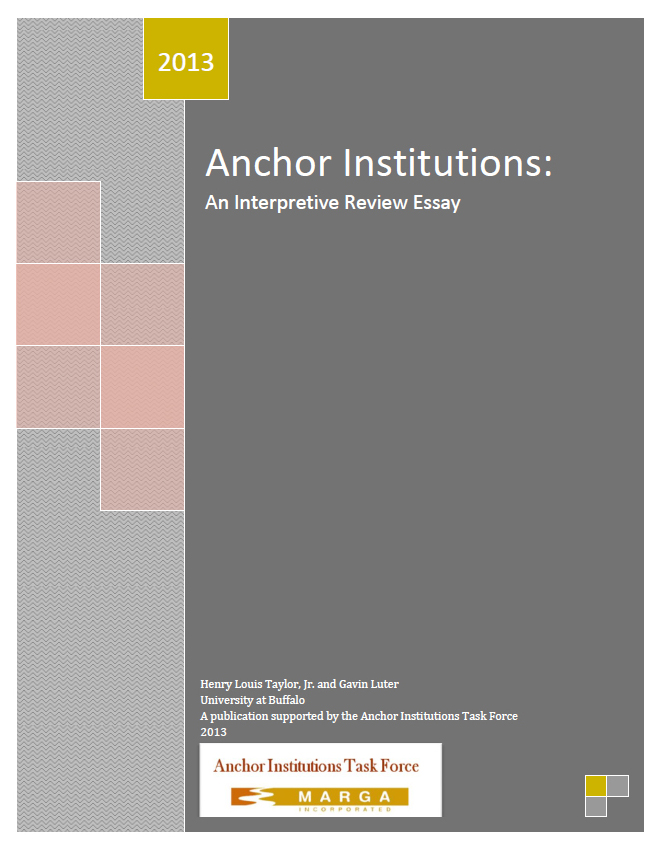IN THIS ISSUE:
Grantee Spotlight: Universities Share Housing Counseling with Their Communities and Each Other
Community (Re)Building in East Biloxi, Mississippi
Anchor Institutions: A Review of the Literature
Anchor Institutions: A Review of the Literature

Henry Lou Taylor, Jr. and Gavin Luter of the University of Buffalo interpret the scholarly literature on Anchor Institutions in a 2013 report published by Marga Incorporated for the Anchor Institution Task Force.
Over the past five decades, institutions of higher education and medicine (“eds and meds”) have emerged as the most common anchor institutions, leveraging their resources to strengthen neighborhoods, cities, and regions. Libraries, museums, arts centers, and community development organizations are among the other institutions investing in their surroundings and the residents and businesses located there. In cities affected by capital flight and deteriorating conditions, these institutions have also come to be regarded as crucial stabilizing forces and agents of change.
The Anchor Institutions Task Force, a think tank that advocates for anchor institutions participating in community development, commissioned "Anchor Institutions: An Interpretive Review Essay," which discusses anchors’ practices and prospects as presented in research published since 2000. The literature review addresses the concept of anchor institutions, the role of anchor institutions in community development, the importance of a social purpose for anchor institutions, and recommendations for future research.
The Concept of Anchor Institutions
In the late 1990s and early 2000s, two economic trends significantly affected urban areas. The U.S. economy’s base shifted from manufacturing to services, and state and local governments took on many new duties that were once federal responsibilities. As urban conditions worsened and fiscal resources became increasingly scarce, academic and medical institutions emerged as much-needed sources of job growth and economic vitality, and anchor institutions emerged as a new concept for understanding the role of universities, hospitals, and other place-based institutions in community development.
Finding no commonly accepted definition of anchor institutions, the report’s authors describe them as large nonprofit organizations whose buildings, mission, customers, or employees make relocation difficult. The report emphasizes that geographic rootedness makes certain institutions well suited for addressing community needs and acting like anchors. Although no minimum size threshold exists for institutions to qualify as anchors, research suggests that they must be large enough to have economic and cultural significance in their communities. Researchers agree that anchor institutions are nonprofit organizations, although the report notes that certain private organizations such as banks, local newspapers, and utility companies can also function as anchor institutions.
Role in Community Development
The report also discusses how anchor institutions, particularly eds and meds, can use their significant resources to promote the social and economic development of their communities. In addition to creating jobs, universities and hospitals contribute to community development by making capital investments, procuring goods and services locally, improving public education, providing workforce training and development programs, hosting business incubators, and developing real estate.
To make this point, the report highlights David Shaffer and David Wright’s study of the economic development initiatives undertaken by some of the State University of New York (SUNY) schools and several other colleges and universities. The researchers found that the higher educational institutions participated in a range of local revitalization activities, offered their extensive knowledge to businesses, and applied their research capabilities to explore opportunities presented by the new economy. Most important were the extensive educational programs made available to community residents. From that experience, the researchers concluded that the institutions’ work represented a new model of economic development, driving advances in the knowledge economy.
Social Purpose Mission
The report emphasizes that anchor institutions must do more than participate in the social and economic development of their communities. Anchor institutions must also accept, or at least be willing to accept, social responsibility as a critical part of their mission. Although the literature shows that not all anchors have a social–purpose mission, the report concludes that they must have the potential to acquire one. A mission of social responsibility redirects an institution’s culture, organization, and activities so that it can fully engage with the community to bring about a better society.
The report also identifies two approaches in the literature to institutions’ ability to sustain their anchor activities over time. One is simply that institutions must commit to activities out of a sense of social responsibility. The other is that their commitment must evolve into an understanding that their activities have shared value — that the anchors, while benefiting their communities, are also acting in their own self-interest.
Recommendations for Future Research
The report notes that the existing literature on anchor institutions is substantial. Nevertheless, the authors suggest additional research is needed to better understand what anchors are and what they do, as well as how effective their activities are. Noting that most research has concentrated on urban colleges and universities, the authors recommend that cultural and religious institutions, community organizations and foundations, and national nonprofits be studied. Research should also explore the potential of geographically fixed businesses and anchor activities in rural areas. Another important area of future research is public school reform as a tool for community development, which the authors consider to be possibly the most important task for building a better society. The authors also recommend three other areas of future research: theory; public policies to support anchors’ activities; and evaluation of programs, including the development of a set of indicators.
Anchor institutions and the Anchor Institutions Task Force’s work will be discussed in detail at the Task Force’s conference on anchor institutions on December 10, 2013 in Baltimore, Maryland.


